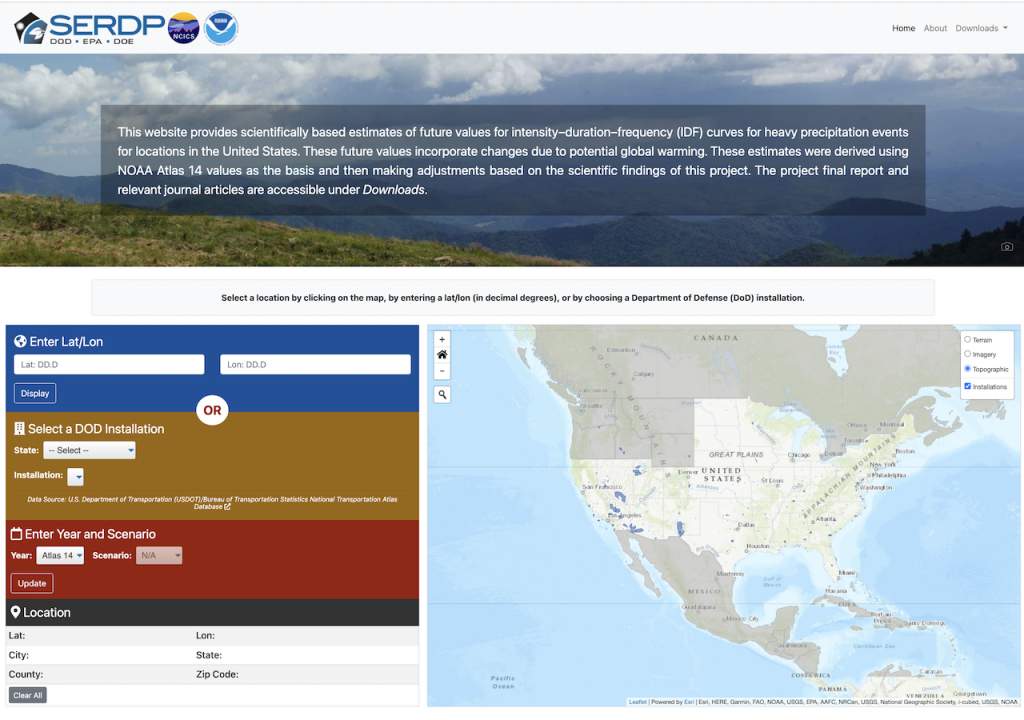New design values for the intensity, duration, and frequency of heavy precipitation account for the projected effects of climate change. An interactive website provides easy access to these projected design values for locations across the US to inform resilient infrastructure design.
As a warming climate continues to drive increases in the frequency and intensity of heavy precipitation events, civil engineers and others tasked with designing resilient infrastructure need reliable information about how these extreme events will change in the future. To help meet that need, researchers from NCICS and NOAAʻs National Centers for Environmental Information developed projected statistics for the intensity, duration, and frequency (IDF) of future precipitation events that account for the expected influence of climate change.
The statistics and details on the methodology are now available via an interactive website at https://precipitationfrequency.ncics.org/.
This work builds on NOAA’s Atlas 14, which provides historical data on the frequency of heavy precipitation events and serves as a critical resource in many areas of the US for designing stormwater management systems and other infrastructure that can cope with expected heavy precipitation events.

Projected future statistics on the intensity, duration, and frequency (IDF) of extreme precipitation events are available at https://precipitationfrequency.ncics.org/ for any location in the United States, except for five states in the Pacific Northwest. Users can click on a location on the interactive map (right panel) or enter a specific latitude and longitude or select from a list of Department of Defense installations (left panel). Current NOAA Atlas 14 IDF values are provided along with projections for seven future periods under two future emissions scenarios.
While Atlas 14 is a critical resource, its statistics are based on the assumption of a stationary climate, where extreme events occur at roughly the same frequency as in the past. But heavy precipitation events are already becoming more frequent and severe in many parts of the US, and further increases are expected as greenhouse gas emissions continue to warm the planet.
The new IDF values are designed to account for these future changes in extreme precipitation from human-induced climate change. They were developed as part of a five-year research project funded by the Department of Defense’s Strategic Environmental Research and Development Program. The overarching goal of the project was to enhance the resilience of defense installations around the country to changes in heavy precipitation.
The new IDF statistics are available everywhere in the US, except for five states in the Northwest where NOAA Atlas 14 values are not available. Values are provided for two scenarios with moderate (RCP4.5) and high (RCP8.5) levels of future greenhouse gas emissions and for seven future 30-year time periods centered on the years 2025, 2035, 2045, 2055, 2065, 2075, and 2085. You can select a location by clicking on a point using an interactive map or by entering specific longitude and latitude values. You can also choose a Department of Defense location by selecting the state and installation name from drop-down menus.
The projected IDF values and associated uncertainty estimates are based on global climate model projections, downscaled model results that provide more localized projections, and research on expected changes in water vapor and weather patterns. Other significant outcomes from the project include the development of a deep learning neural network model for identifying weather fronts in climate model data and extensive research into the key drivers of heavy precipitation events and how they are expected to change in the future.
Key conclusions of the research suggest that
- changes in the more extreme events, such as those that would be expected to occur only once every 100 years, will be larger than in less rare events;
- the future changes will increase substantially with higher levels of future greenhouse gas emissions;
- the future changes will be very large by the end of the century under the highest emissions scenario studied;
- the spatial variability will be relatively small compared to the magnitude of the changes by the mid- to late 21st century; and
- future changes will generally decrease slightly with increasing duration.
Technical details, the final report project, and related peer-reviewed publications are available via the “About” page and the “Downloads” menu.
Media Contact
Tom Maycock
Science Public Information Officer
NC State University’s North Carolina Institute for Climate Studies
tmaycock@ncics.org
828-271-4272
